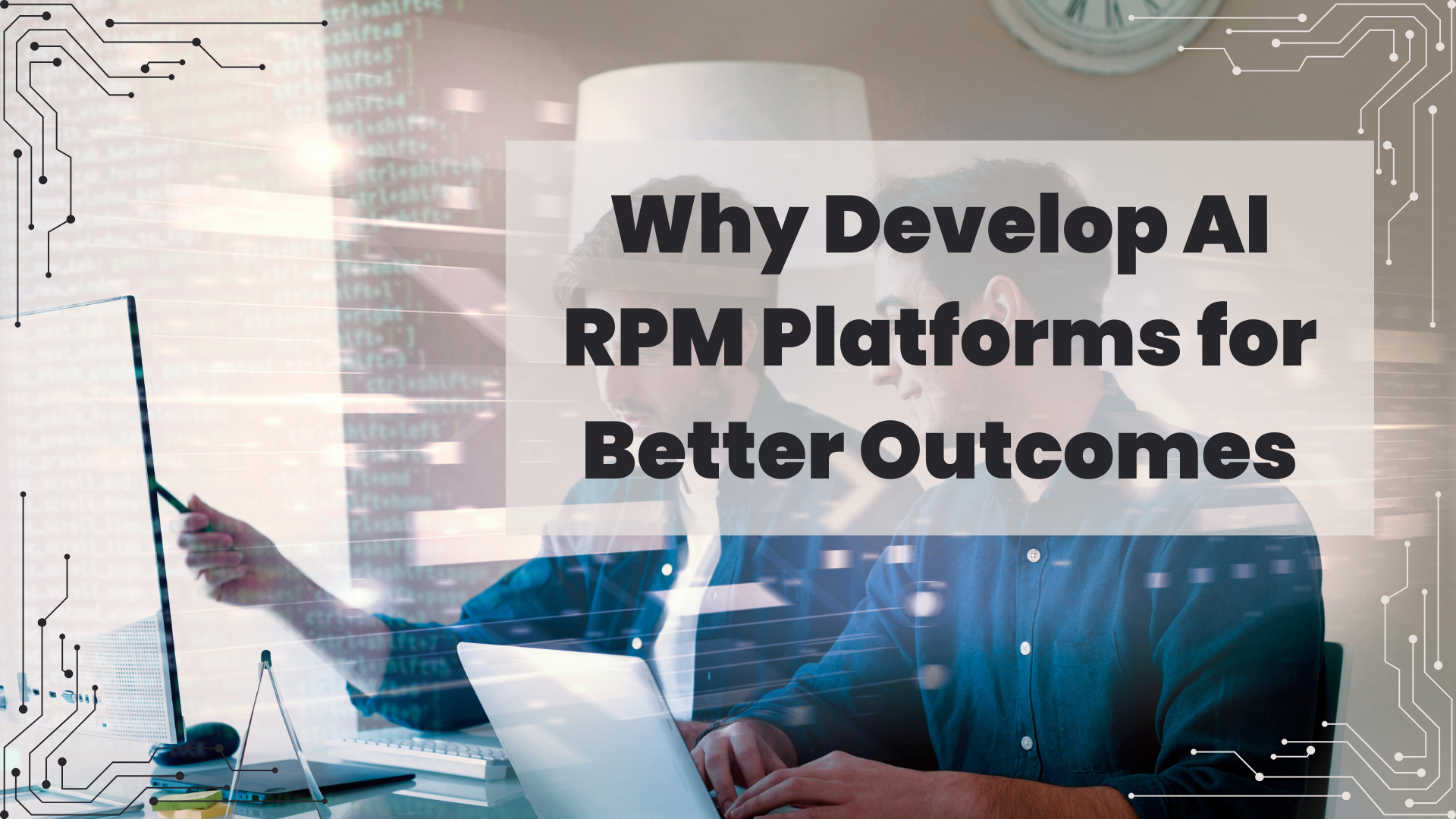Why Develop AI RPM Platforms for Better Outcomes

Remote Patient Monitoring (RPM) has quietly revolutionized the healthcare landscape. Once viewed as a futuristic concept, it is now a critical component of modern medicine—bridging the gap between hospitals, clinics, and homes. Yet, as the world moves toward data-driven healthcare, it’s becoming increasingly clear: RPM systems alone are not enough.
To deliver true clinical precision, predictive capability, and patient-centric efficiency, these systems must evolve. That evolution begins with Artificial Intelligence (AI).
AI-enhanced RPM platforms are redefining how healthcare is delivered—moving from observation to prediction, from treatment to prevention, and from data collection to actionable insight. But developing such platforms isn’t just a technological choice—it’s a strategic one that determines how well healthcare providers achieve the holy grail of modern medicine: better outcomes at lower costs.
The Modern Healthcare Challenge: Data Without Direction
In the era of connected health, the volume of patient data is immense. Wearables, home monitoring devices, smart scales, and biosensors continuously capture vital signs—heart rate, oxygen levels, glucose, sleep, blood pressure, and more.
But without AI, this data is like static—voluminous, unstructured, and often overwhelming.
Healthcare professionals face a paradox:
-
Too much data, but too little insight.
-
Continuous monitoring, but limited predictive value.
-
Automation, but fragmented systems that don’t communicate.
The result is inefficiency. Nurses manually triage alerts, doctors drown in dashboards, and patients receive generalized advice instead of personalized care.
That’s where AI development transforms the equation—turning RPM from a passive observer into an intelligent collaborator.
Why RPM Needs AI at Its Core
Remote patient monitoring without AI is like a stethoscope without a clinician—it collects information but doesn’t interpret it. AI acts as the cognitive layer that gives RPM its true purpose: meaning, prediction, and precision.
The Core Value AI Brings to RPM
-
Data Intelligence: AI transforms continuous data streams into clinical-grade insights.
-
Predictive Accuracy: Machine learning detects health deterioration before symptoms appear.
-
Personalization: Algorithms tailor interventions based on individual baselines.
-
Efficiency: Automated triage reduces clinical burden and improves decision-making.
-
Scalability: AI systems can monitor thousands of patients simultaneously with consistent precision.
By embedding AI into RPM platforms, healthcare shifts from reactive care—treating illness—to proactive care—preventing it.
The Architecture of an AI-Enabled RPM Platform
Developing a powerful AI RPM platform is a strategic blend of engineering, compliance, and clinical intelligence. Here’s what it looks like under the hood:
1. Data Capture Layer
This is where health data originates—from:
-
Wearable sensors and smart devices
-
Home-based diagnostic tools
-
Electronic Health Records (EHRs)
-
Environmental and lifestyle data sources
The system must ensure high-quality, continuous, and secure data transmission.
2. Integration Layer
Healthcare data comes in many formats—structured, semi-structured, and unstructured. APIs and interoperability standards like HL7 and FHIR unify these data streams into a single ecosystem, creating a 360-degree view of the patient.
3. AI Processing and Analytics Layer
This is the intelligence hub where AI models process incoming data in real time.
-
Predictive Models: Anticipate adverse events before they occur.
-
Anomaly Detection: Flag deviations from individual baselines.
-
Natural Language Processing: Interpret clinical notes or patient feedback.
-
Reinforcement Learning: Adapt recommendations based on continuous feedback loops.
4. Visualization and Feedback Layer
Data must be interpretable to be useful. Interactive dashboards present insights in human-friendly formats: risk scores, alerts, progress metrics, and predictive trends—enabling doctors and patients to act quickly.
5. Compliance and Security Layer
Since RPM platforms handle sensitive health data, they must adhere to HIPAA, GDPR, and FDA standards. Encryption, access control, and anonymization form the ethical backbone of AI-powered healthcare.
The Tangible Benefits of Developing AI-Driven RPM Platforms
For organizations, AI-enhanced RPM isn’t an upgrade—it’s a competitive necessity. The benefits ripple across the entire healthcare ecosystem.
For Providers and Hospitals
-
Early Intervention: Predictive analytics detect deterioration early, reducing hospitalizations.
-
Operational Efficiency: AI triages alerts automatically, saving hours of manual review.
-
Clinical Confidence: Accurate, validated data supports better diagnosis and decision-making.
-
Resource Optimization: Staff can focus on complex cases while AI manages routine monitoring.
For Patients
-
Continuous Care: Monitoring doesn’t stop when the patient leaves the hospital.
-
Personalized Guidance: Recommendations are based on individual health trends, not generic averages.
-
Safety and Reassurance: Real-time alerts ensure timely intervention and peace of mind.
-
Empowerment: Patients gain visibility into their progress and control over their care journey.
For Healthcare Systems and Insurers
-
Reduced Costs: Preventive monitoring cuts readmission and emergency visit rates.
-
Scalable Care Models: Fewer in-person visits required for chronic condition management.
-
Value-Based Care Compliance: Data-backed outcomes align with reimbursement frameworks.
AI doesn’t just make RPM more accurate—it makes it smarter, cheaper, and more humane.
From Reactive to Predictive: The AI Advantage
The defining power of AI in RPM is its ability to shift healthcare from reactive to predictive.
Predictive Prevention in Action
-
AI analyzes subtle heart rhythm variations to warn of arrhythmia risks days in advance.
-
It correlates glucose spikes with meal logs and activity data to recommend dietary changes.
-
It identifies abnormal breathing patterns to predict COPD flare-ups before they escalate.
Predictive systems don’t just monitor—they anticipate. And in healthcare, anticipation saves lives.
Enhancing Chronic Disease Management
Chronic illnesses—diabetes, hypertension, heart disease—account for the majority of global healthcare spending. AI-driven RPM platforms provide continuous insight, ensuring these conditions are managed effectively.
Diabetes
AI models predict glucose fluctuations and coach users on diet or insulin adjustments. Continuous data integration enables precision management.
Cardiac Care
RPM devices powered by AI detect arrhythmias, heart rate anomalies, and irregular ECGs with clinical accuracy, helping cardiologists intervene early.
COPD and Asthma
AI interprets respiratory rate, air quality, and medication adherence, predicting exacerbations and reducing ER visits.
Hypertension
AI models personalize medication schedules and activity recommendations, improving blood pressure stability and treatment adherence.
The Power of Personalization
AI RPM platforms redefine personalization. They don’t apply universal benchmarks—they learn individual ones.
Every patient has a unique baseline. A slightly elevated heart rate for one person may be normal for another. AI learns these nuances, reducing false alerts and unnecessary interventions.
Through behavioral data, AI can also adapt recommendations to user habits.
If a patient consistently skips morning medication, the system may send reminders timed to their actual routine.
This fusion of personalization and prediction transforms chronic care into a partnership—between patient, clinician, and machine.
Clinical Efficiency: The Hidden ROI of AI RPM
Beyond patient outcomes, AI-driven RPM delivers measurable financial and operational returns.
1. Reduced Manual Workload
AI automates triage, prioritizing alerts and minimizing data overload. This allows nurses and doctors to focus on critical tasks rather than sifting through raw data.
2. Streamlined Communication
AI-powered chatbots and virtual assistants help patients clarify symptoms or report concerns, reducing administrative follow-ups.
3. Data-Driven Resource Allocation
Predictive insights enable hospitals to forecast patient surges, optimize staffing, and manage supply chains more efficiently.
4. Continuous Learning Loop
Every new data point refines AI models, improving accuracy and efficiency over time—turning operational experience into algorithmic intelligence.
Case Studies: AI RPM in Action
1. Heart Failure Management
A European hospital network deployed an AI-enabled RPM platform that analyzed ECG, oxygen saturation, and weight trends for post-surgical cardiac patients.
Result: 45% reduction in hospital readmissions within six months.
2. Diabetes Control at Scale
An American digital health startup developed an AI RPM solution that combined wearable glucose sensors with behavioral analytics.
Result: Average HbA1c reduction of 1.2 points among active users—significantly lowering long-term complication risks.
3. Elderly Remote Monitoring
A Singapore-based system used AI to track movement, gait, and vital signs in elderly patients.
Result: 60% reduction in fall-related ER visits and improved family engagement through smart alerts.
Each case illustrates one truth: AI transforms RPM from a passive system into an active partner in health.
Overcoming Development Challenges
Building AI RPM platforms is not without complexity. Healthcare leaders and technology teams must address several hurdles.
Data Interoperability
Different devices use different protocols. Developers must ensure seamless integration through standardized APIs and healthcare data frameworks.
Model Validation
AI models must undergo rigorous clinical validation before deployment. Accuracy, reproducibility, and fairness are critical for medical acceptance.
Privacy and Compliance
Handling patient data requires uncompromising adherence to data privacy laws. End-to-end encryption, consent management, and anonymization are vital safeguards.
Patient Engagement
Technology adoption depends on simplicity. Intuitive design, conversational interfaces, and personalized feedback drive user retention.
Ethical Governance
As AI grows more autonomous, organizations must ensure explainability and transparency—so every AI-driven decision can be justified ethically and clinically.
Future Outlook: Where AI RPM is Headed
The next generation of AI RPM platforms will go beyond monitoring—they’ll redefine preventive healthcare altogether.
1. Federated Learning
AI models will learn from decentralized datasets without sharing patient data—balancing accuracy with privacy.
2. Predictive Digital Twins
Virtual simulations of patients will allow clinicians to model treatment outcomes before applying them in real life.
3. Autonomous Health Management
AI will not only detect anomalies but suggest interventions, coordinate prescriptions, and alert emergency services automatically.
4. Integration with Genomics and Lifestyle Data
AI will merge RPM data with genetic, environmental, and behavioral insights—creating hyper-personalized care models.
5. Collaboration with Telemedicine
RPM will merge seamlessly with virtual consultations, creating end-to-end digital care ecosystems.
These innovations will blur the boundaries between hospital, home, and technology—creating continuous care environments centered on the patient.
Why Now is the Time to Invest
Healthcare’s digital acceleration—driven by global aging, chronic disease burden, and workforce shortages—has created a tipping point.
Organizations that invest in AI RPM development today gain:
-
Operational resilience: Automated systems that reduce clinician dependency.
-
Scalable capacity: Ability to manage more patients with fewer resources.
-
Competitive differentiation: Technology leadership in a rapidly consolidating market.
-
Improved patient loyalty: Personalized, data-driven experiences drive engagement and retention.
In short, AI RPM is no longer a “nice-to-have” tool—it’s a strategic imperative for sustainable healthcare delivery.
The C-Suite Perspective: Strategic Recommendations
For executives exploring AI RPM development, strategic clarity is key.
-
Align Technology with Care Goals
Don’t build tech for tech’s sake. Design platforms that directly enhance clinical, operational, and financial outcomes. -
Invest in Partnerships
Collaborate with data scientists, clinicians, and regulatory experts. AI in healthcare thrives at the intersection of disciplines. -
Prioritize Explainability and Ethics
Choose models that are transparent and auditable—ensuring trust among patients and regulators. -
Adopt Scalable Architecture
Use modular systems that can expand across new conditions, devices, and care models without structural overhaul. -
Commit to Continuous Learning
The healthcare environment evolves—so should your AI. Establish retraining pipelines to ensure models remain relevant and accurate.
The leaders who combine technological insight with patient empathy will define the next decade of healthcare.
The Ultimate Goal: From Monitoring to Meaningful Outcomes
Developing AI RPM platforms is not about digitizing care—it’s about humanizing it through intelligence.
By translating real-time data into predictive insights, AI ensures interventions happen not after a crisis, but before one.
By personalizing care plans, it respects the uniqueness of each patient.
And by automating repetitive tasks, it frees clinicians to focus on empathy, not paperwork.
Better outcomes aren’t just about survival—they’re about sustained wellness, dignity, and trust.
AI makes those outcomes measurable, repeatable, and scalable.
Conclusion
Developing AI RPM platforms is a pivotal step toward transforming healthcare from reactive treatment to predictive prevention. These systems improve accuracy, strengthen patient engagement, and empower providers to make faster, data-informed decisions that truly enhance outcomes.
For organizations ready to lead the future of digital health, partnering with experienced specialists in AI software development services ensures that every platform built is secure, compliant, and purpose-driven—turning remote monitoring into real-world healing.




